AVOIDING DISADVANTAGES AND SEEKING ADVANTAGES
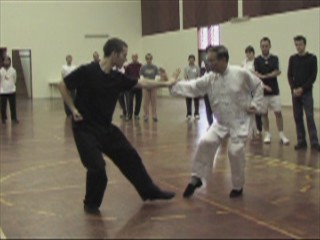
Sifu Jamie Robson opens Grandmaster Wong's defence and is about to move in to attack
In today's free sparring, many martial artists do not realize that they have given away many disadvantages of themselves to their opponents, without their opponents having to do anything. This is what we call “free-offers”. Some examples are rushing in to attack exposing their body openly, or kicking high and exposing their groin.
All the opponents have to do is to exploit these free-offers and defeat the attackers. However, their opponents often do not know about these free-offers, and hence cannot exploit them for their advantages..
In our combat training, the first principle is to ensure that we are safe. It doesn't mater if we lose a fight but come out unhurt. Some martial arts have a different philosophy. They advocate win at all cost, even sustaining serious injury. Such martial arts pay little attention to safety first. Some are meant to be sports, and as the practitioners are protected by safety rules they often neglect to ensure their own safety first in combat.
To ensure safety, we do not give away disadvantages to our opponents. Not covering the opponent's guard-hand before attacking, and adopting footwork that exposes your groin are obvious examples of free-offers. Less obvious examples are attacking while your chi is floating, and making movements without focus.
Then we should be able to recognize free-offers our opponent may give us and exploit them. But we need to be careful that they are free-offers carelessly made by our opponents and not feint moves or tactics to trick us.
If your opponents are well trained, they will not give away free-offers. In this case we have to create our own advantages. This can be realized by employing tactics and strategies.
The video clips show how you can avoid disadvantages and seek advantages as learnt and practiced at the Sabah Intensive Shaolin Kungfu Course in March 2007.
Be elegant, focused at the dan tian and mentally calm and fresh

Besides the three external harmonies of feet, body and hands, a practitioner must also attain the three internal harmonies of essence, energy and mind. His form must be elegant, his qi (chi) focused at his dan tian, and he is calm and fresh. If he is tensed, panting for breath or distracted, he would have missed these three internal harmonies, and would perform below par in his combat.
Correct Spacing in Responding to an Attack
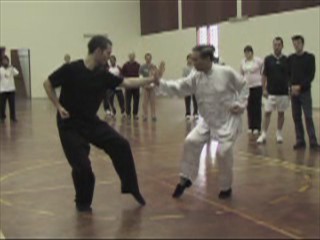
When responding, ensure that your spacing is correct. If you move too far away, you may avoid an opponent's attack but miss a good opportunity of counter-attacking. If you are too close, you may not be effective in neutralizing his force, and worse, you may be hit.
The Three Points of Response

Beside spacing, timing must be correct. Of course if you respond too slowly, you would be hit. But responding too fast is also incorrect. The timing may be at the initial stage of the attack, when the attack is in he middle of its progress, or when the attack is about to be completed. If you are at the beginning stage of our combat training, you need not worry about these details. Begin your response when the attack has started, not before.
Weakness of Responding Too Quickly
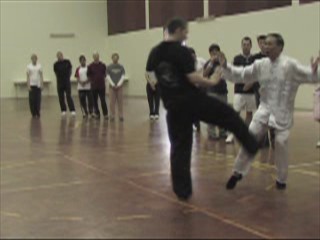
Many martial artists respond too quickly to an attack. As soon as an attacker makes a movement, they instinctively bounce away. If the attacker is skillful and trained, this can be a weakness. The attacker may abandon his initial attack, move in swiftly and attack deeply following the momentum of the retreating responder. Moreover, responding too quickly negates the effectiveness of counter-attacking if the attacker offers this opportunity. Thirdly, it negates the training of shen, or mind.
Tactic of Minimum Force against Maximum Strength

A common mistake amongst beginners is to use “Single Tiger Emerges from Cave” to block an opponent's attack. This pattern is not a block, but a leaning technique. You “lean”, not block, your Tiger-Claw on the opponent's forearm. When you block, you use force against force; but when you lean you need only minimum force. This is a useful tactic to avoid an opponent's powerful attack and prevent him from further attacks.
Safety First and Exploding Force
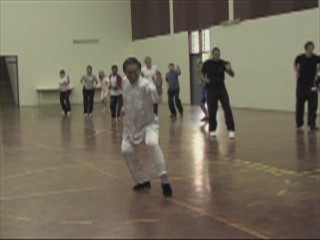
Notice that Grandmaster Wong starts with his back leg, rotates his waist and complete with his punch -- the three factors (feet, body, hands) constituting the three external harmonies. Notice also that Grandmaster Wong asks the way with his leading hand which ensures his own safety first, and his punch spirals out from his waist with the force exploding from the dan tian.
Helping One Another in Combat Training

Remember that in combat training, the one in front of you is not your deadly enemy but your sparring partner. You should, therefore, help each other.
Threading to Minimize Opponent's Force
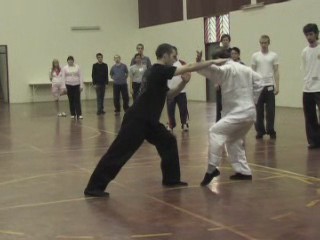
The “thread” is an effective technique to realize the tactic of using minimum force against maximum strength. First, Grandmaster Wong shows the application of the thread with wrong timing and wrong spacing. Then Grandmaster Wong shows its application correctly. Notice that it is not a block.
An Example of a Free-Offer

This video clip shows a common mistake made by many students, i.e. moving into an opponent's guard hand. It is a free-offer. The opponent would just strike you as you move in.
More Examples of Free-Offers
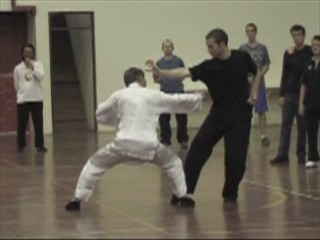
Here are more examples of free-offers. When moving in to execute a low stance arrow punch as in the pattern “Precious Duck Swims Through Lotus”, students often move in too close, thus moving into an opponent's strike. They also fail to cover the opponent's guard-hand, thus exposing themselves to counter-attacks.
LINKS
Review of the Intensive Shaolin Kungfu Course in Sabah in March 2007
- Overview 1 : The Fundamentals
- Overview 2 : The 16 Combat Sequences
- Overview 3 : Are They Performing Kungfu Dance?
- The Basics of Shaolin Kungfu Training
- Fundamental Combat Skills
- Defeat you Hand to your Opponent, Victory you Create Yourself
- Avoiding Disadvantages and Seeking Advantages
- Basic Principles and Tactics of Combat
- Skills derived from Sparring can be Rewardingly used in Daily Life
- Some Secrets in Practicing Genuine Kungfu
-
Various Ways to Move into an Opponent
- Applying Combat Sequences in Sparring
- Linking Sequences to be More Combat Efficient
- The Secrets of Continuous Cannons
- The Mechanics of Continuation
- Marvelous Techniques Beget Marvelous Techniques
- Perfecting Forms and Developing Force
- Applying Tactics in Combat
-
Objectives of Form Training in Solo
- Being Fluent in Kicking Techniques before Applying them in Combat
- Using Tactics in Kicking Attacks and Defences
- Different Levels of Sophistication in Sparring and Fighting
- The Legacy of Uncle Righteousness: Secret of Continuous Cannons and their Counters
-
Benefiting from the Experiences and Teachings of Past Masters
- Poetic Patterns Can be Very Deadly
- Moving Back One Step when in Diffiuclt Situations
- Linking Sequences to Form a Kungfu Set
- Felling Techniques in Kungfu are Different from Judo and Wrestling
- Butterfly Palms and Hiding Flowers are Excellent in Countering Felling and Gripping Attacks
-
Let Mercy Flow from the Hands
- Benefits of Solo Set Practice — Combat Sequences 13 to 16
- From Pre-Choice Sequences to Free Sparring
- Applying Shaolin Patterns Correctly and Spontaneously in Free Sparring
- Shaolin Kungfu against Boxing and Kick-Boxing
- Shaolin Counters against Wrestling Shoots
- The Secret of Grandmaster Ho Fatt Nam
- Why Shaolin Kungfu is Technically Faster than Boxing
- Shaolin Techniques, Tactics and Strategies against Boxing
- Revealing Secrets of Past Taijiquan Masters
- Overwhelming Opponents with Just One Pattern
- Poetry and Elegance in Effective Combat
